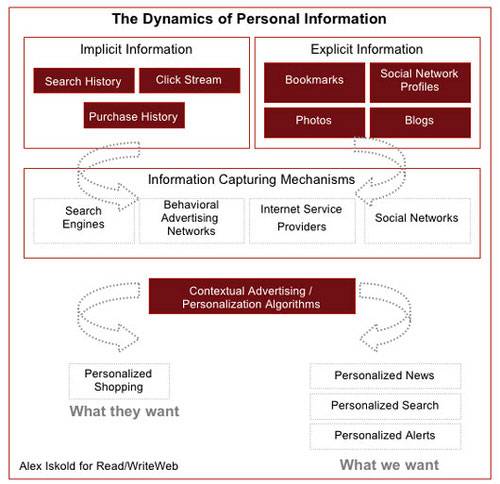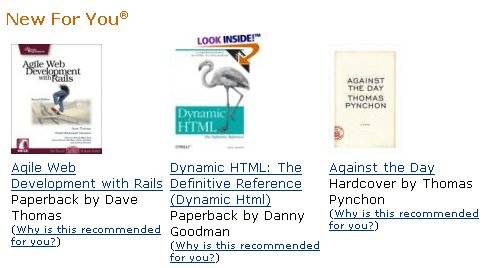This week we are talking about personalization and privacy is an important, related topic.
To personalize pages companies need to know things about us – what we like, what we’ve seen,
what we read and what we purchased. Online retailers are in the business of capturing our information
to give them a competitive advantage over their competitors.

On the other hand with the rise of social web we have begun voluntarily putting our private information online.
We blog our corporate strategies, share our family photos, and make lists of our interests.
Yet most people are still concerned about privacy. They may not know exactly what it is that makes them so concerned,
but they are concerned. In this post I will look at privacy in the context of personalization from user concerns
to target advertising and ownership of clickstreams.
Why Are We Concerned About Privacy?
Many times over the past few years I had conversations where people asked: But what about privacy?
My answer is always: What exactly are you concerned about? The majority of people just worry about privacy as a word;
they can’t express what it is that worries them. It is a conservative, mostly uninformed behavior: “I just don’t
want them to know about me.”
This is a rather naive position. First of all, “they” do know about you and you agreed to it when you did not uncheck the privacy box.
So a better worry would be to find out who they are and what they are going to do with your information.
Obviously, you do not want your information to be used against you. And that is the real reason that people are concerned about privacy.
It’s Not You, It’s Your Money They Are After!
The good news about the people stalking our online behavior? They don’t want to hurt us, they just want our money. The reason
retailers want to know our private information is because they want sell us things.

Google is the reigning king of the web because it solved a simple problem – how to effectively
advertise to users. As it turned out, the answer was embedding ads into the search results.
But the search engine is not the end, it is merely a means to an end. It is the advertising that makes the whole
system work.
Google ads, however, are contextual, but they are not personalized (at least not yet).
Google delivers advertising based on the content of your search results, which certainly works well, but could
work even better if the search results, and the ads, were tailored to the specific end user. This is not
possible to do without knowing your personal information.
The Behavioral Targeting is Personalization
In our earlier post this year, The Art, Science and Business of Recommendation Engines
we discussed the main ways that personalization engines like Google, Amazon and Last.fm work:
- Personalized recommendation – recommend things based on the individual’s past behavior
- Social recommendation – recommend things based on the past behavior of similar users
- Item recommendation – recommend things based on the thing itself
- A combination of the three approaches above
Effectively Google is an item or context-based recommendation engine and Last.fm is the social recommendation engine.
Amazon has a combination of all approaches, but most notably, Amazon has recommendations based on your past
experiences, such as what you’ve previously purchased, rated, or looked at.

The problem for Amazon’s competitors is that practically no other retailer has the kind of information that Amazon has to
do this kind of personalization. To solve the problem, we have seen a range of Behavioral Targeting solutions.
All of these solutions utilize clickstream information to show you a targeted ad.
For example, companies like Tacoda create user profiles by
serving and tracking cookies from hundreds of web sites. Using sophisticated algorithms they assign
users to different categories by interests, but they never identify you specifically. Based on the collected
information they are able to show you and other people like you relevant advertising.
Tacoda enables relevant ads and from that point of view it is the same as Amazon – both try to maximize clicks.
The difference is really in how the private information is being used. In Tacoda’s case, the information
is anonymous, it does not know that you are really you. But Amazon does.
Who Owns The Information?
This brings us to the crux of the issue – who owns our attention or behavioral information? Earlier
this year, I attended the Open Data
workshop in New York City, where influencers from the industry spent a day debating this issues. The split was
about even, 50% of the attendees thought that tracking people via cookies is perfectly fine, while the rest
thought it was wrong.
Intuitively, the information belongs to the consumer, but when we look into the details, things become
less clear. We explicitly choose to use Amazon, to click and to buy things there. Everything we do is a two way street, since Amazon provides a service and we transact with it, it seems that they should have a right
to the data as well.
In case of the Tacoda, things are also not simple. Tacoda’s technology is installed
on the sites that you are visiting. In the fine print on those sites there are disclaimers. You click and transact
with these sites just like you do with Amazon. Why should this be any different? It seems that the sites have the right
to leverage your information.
Conclusion
Privacy is a very controversial topic. Everybody has an opinion and everyone is concerned about how their information is being collected, stored, and used.
It is particularly odd to hear privacy concerns and then login into Facebook and see people putting
everything about themselves in their profiles. But such is the day and age we live in.
To effectively
settle these privacy issues and the dispute over ownership of information we need laws. Without specifics, all we get
is what it says in the Fifth Amendment of the US Constitution: nor shall private property be taken for public use, without just compensation.
But does that include clickstream? That is truly a billion dollar question.










